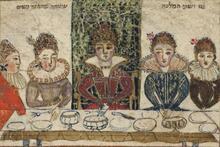Vashti: Bible
The first wife of Ahasuerus, the king of Persia, Vashti is the featured character in the first episode of the Book of Esther. Ahasuerus summons Vashti to appear before the company with her royal crown upon her head, so he can show off her beauty. When she refuses, the enraged king sends her away permanently, thus setting in motion the chain of events that will make the Jewish Esther the queen of Persia.
The first wife of Ahasuerus (Xerxes I, reigned 485–465 B.C.E.), the king of Persia, Vashti is the featured character in the first episode of the Book of Esther, a Jewish novella composed in the late Persian/early Hellenistic period (fourth century B.C.E.). King Ahasuerus, in the midst of a banquet with his noblemen, summons Vashti to appear before the company with her royal crown upon her head, so that he can show off her beauty. She refuses (her reasons are not given, although the rabbis speculated that she was summoned to appear naked), and the king, enraged, sends her away permanently, thus setting in motion the chain of events that will make the Jewish Esther the queen of Persia.
Vashti’s Characterization
As in many other biblical stories, the narrator does not comment directly on whether the characters’ actions are right or wrong. However, the portrayal of the king and his advisors satirizes their supposed power and wisdom while casting Vashti in a positive light. It is specified that Ahasuerus asks for Vashti to appear “when the heart of the king was merry with wine,” hinting at the frivolity of his request. The royal advisors propose that Vashti must be punished for her disobedience or else the noblewomen who hear of her refusal will likewise disobey their husbands. Yet the decree banishing her, intended to affirm that all women must honor their husbands, only serves to further publicize Vashti’s fame throughout the empire. Ironically, Vashti’s banishment fulfills her very desire not to appear before the king. Later, the king regrets his decision to banish Vashti but cannot turn back on his word.
Vashti Compared to Esther
Although sometimes regarded as incidental to the main plot of the Book of Esther, the Vashti story introduces themes that will become important later in the book, such as the manipulability of King Ahasuerus and his habit of enacting new laws at the suggestion of others. Esther takes advantage of the king’s weakness (especially under the influence of wine) as she hosts a wine banquet when persuading Ahasuerus to save the Jewish people. Further parallels between the two characters bring Esther into comparison with Vashti. In order to replace her as queen, Esther must be what Vashti was not: obedient to the king’s wishes. Esther is portrayed as docile and submissive as she is taken into the king’s harem before being made queen. But in the end, Esther like Vashti, also defies the king’s law. In a mirror image of Vashti’s disobedience, Esther comes to the king unbidden, whereas the former queen refused to appear before the king when summoned. Readers throughout the centuries have found inspiration in both Vashti and Esther as women who confronted men in power at the risk of their positions and lives.
Amsellem, Wendy. “The Mirror Has Two Faces: An Exploration of Esther and Vashti.” JOFA Journal 4 (2003): 7. See: https://www.myjewishlearning.com/article/vashti-esther-a-feminist-perspective/
Berlin, Adele. The JPS Bible Commentary: Esther. Philadelphia: Jewish Publication Society, 2001.
Carruthers, Jo. Esther Through the Centuries. Oxford: Blackwell, 2008.
Fox, Michael V. Character and Ideology in the Book of Esther. Grand Rapids, MI: W.B. Eerdmans 2001.
Levenson, Jon, D. Esther: A Commentary. Louisville, KY: Westminster John Knox 1997.
Meyers, Carol, General Editor. Women in Scripture. Boston: Houghton Mifflin, 2000.
Reimer, Gail Twersky. “Eschewing Esther/Embracing Esther: The Changing Representation of Biblical Heroines.” In Talking Back: Images of Jewish Women in American Popular Culture, edited by Joyce Antler, 207-19. Hanover, NH: Brandeis University Press, 1997.
White, Sidnie A. “Esther.” In Women’s Bible Commentary, edited by Carol A. Newsom and Sharon H. Ringe, 124–129. Louisville, KY: Westminster John Knox Press, 1992; expanded edition, 1998.
White, Sidnie A.. “Esther: A Feminine Model for Jewish Diaspora.” In Gender and Difference in Ancient Israel, edited by Peggy L. Day, 161–177. Minneapolis: Fortress Press, 1989.
Zornberg, Avivah. “Esther—Mere Anarchy Is Loosed upon the World,” in The Murmuring Deep, 108-109. New York: Schocken, 2011.










